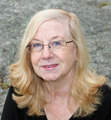Lea Wait's Blog, page 122
December 18, 2020
The Books We’re Giving and Hoping to Get This Year
Today we’re sharing a list of the books we’re thinking of giving this year and perhaps some that we’d like to receive. What about you, readers? Are there books you’re excited about giving or getting?
Kate Flora: I’m looking forward to given some very young people a copy of The Library Lion, since it is a charming book and libraries are my favorite places. I’ve snagged a copy of The Best American Science and Nature Writing for my son. I’m hoping to get a copy of The Complete Mediterranean Cookbook.
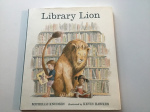
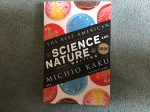
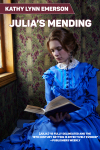 Kaitlyn Dunnett/Kathy Lynn Emerson: Since I haven’t done a bit of Christmas shopping this year, not that I’m all that fond of it anyway, assorted relatives are getting copies of my books, the ones published this year. That’s actually quite a haul, considering I had three mysteries traditionally published, two as Kaitlyn and one as Kathy, and self published (or reissued) eight more, six for children
Kaitlyn Dunnett/Kathy Lynn Emerson: Since I haven’t done a bit of Christmas shopping this year, not that I’m all that fond of it anyway, assorted relatives are getting copies of my books, the ones published this year. That’s actually quite a haul, considering I had three mysteries traditionally published, two as Kaitlyn and one as Kathy, and self published (or reissued) eight more, six for children  ages 8-12 and two nonfiction books in the history/biography category. Books I want? Honestly, I’d just as soon buy them myself. The family can give me cat- or Star Wars-themed doo-dads, the way they usually do.
ages 8-12 and two nonfiction books in the history/biography category. Books I want? Honestly, I’d just as soon buy them myself. The family can give me cat- or Star Wars-themed doo-dads, the way they usually do.  What can I say? Small family. Not all that into Christmas except as a chance to get together and catch up. Gifts aren’t really that big a part of it. especially now that there are no little children to give to. But books, of course, are great gifts to give to anyone all year ’round.
What can I say? Small family. Not all that into Christmas except as a chance to get together and catch up. Gifts aren’t really that big a part of it. especially now that there are no little children to give to. But books, of course, are great gifts to give to anyone all year ’round.
Charlene D’Avanzo:
Since I’m a scientist, many of my book gifts and requests lean toward nerdy. Don’t tell my husband, but I just got him the brand new 2020 “What It’s Like To Be A Bird” by the famous David Allen Sibley. In the tome Sibley answers questions like Can Birds Smell?” and “Do Robins ‘Hear’ Worms?” plus other most often asked questions about birds we see all the time. On Christmas morning my brother will unwrap “Around the World in 80 Trees” by Jonathan Dori, said to be the “perfect book for tree lovers”. Charlene D’Avanzo
Maggie Robinson: I am doing something very sneaky this year. Not precisely regifting, but toeing the line, LOL. My best friend lives in Virginia, and has cultivated a spectacular garden over the years. As you can imagine, I have gnashed my teeth every spring when she sends me pictures of daffodils when we in Maine still have three feet of snow outside. Her garden has been the setting of several weddings, two of which I’ve attended–one in May and one in October and both absolutely beautiful in terms of seasonal blooming. She grows things I don’t know the names of which would probably die in our climate. I admit I’m jealous, although I wouldn’t like to do all the work; I have enough trouble maintaining my small terraced backyard.
I’m a big fan of the English gardener Monty Don, and have watched many of his shows and special series. He’s so mellow and chill I wish I could invite him and his dogs over for tea. When I saw he had a new book out, American Gardens, I pounced on that pre-order. The book arrived a few weeks ago, and I saved the box. After I skim through it for inspiration, I’m sending it to a true gardener, my lovely friend Claudia. Sh. Don’t tell her. 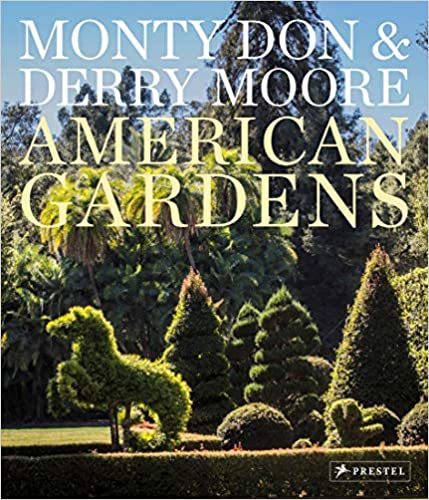
John Clark is giving wife Beth Katie’s Way by our own Kathy Lynn Emerson and Barak Obama’s A Promised Land. Daughter Sara is getting a pre-order of The Scorpion’s Tail by Preston and Childs.
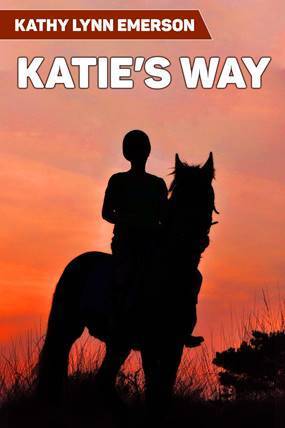
December 16, 2020
COOPED-UP BLUES?
Feeling blue? The you-know-what that starts with p got you down? You aren’t alone. Liquor sales are up. Many people report insomnia, lack of interest in activities they previously did daily or weekly, and downright depression. I know at least three people who have begun counseling because of foggy brains and depression. One woman told me she usually reads two books a week, but now she can’t concentrate on one a month. Writers can’t get words on a page. Artists can’t slap paint on canvas. Dancers slump at the barre. Possibly the approaching holidays will cheer people, but being inside during the cold, dark months might cancel out that temporary high.
Here are some ideas to get you through the cold months, but one size won’t fit all. I hope one or two will resonate with you. You can get outside. You don’t need to stay cooped up. Seriously.
1. Get outside yourself. By that I mean, call a friend or write an old friend. Zoom or Skype or Facetime with friends or family. Donate food or clothing to the Salvation Army or other local nonprofit. Take a dinner or homemade bread or a dessert to a shut-in. Volunteer to pick up and deliver To-Go groceries or prescriptions to people who cannot get out.
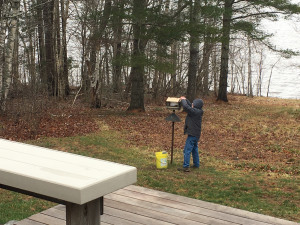 2. Feed the birds. Buy a bird identification book and learn about the birds around you. We have a feeder, with a suet basket, on a pole in our yard. If you’re in an apartment, maybe with a balcony, consider hanging one on a plant hook. Lately the blue jays have mobbed the feeder, scaring away the chickadees and nuthatches. Bob Duchesne, my go-to expert on birds, described exactly that in his Bangor Daily News column “Good Birding” recently and said the phenomenon is widespread, something to do with the lack of food farther north. I was amazed to learn that blue jays stash food in secret spots like squirrels do. My bird books didn’t contain that tidbit.
2. Feed the birds. Buy a bird identification book and learn about the birds around you. We have a feeder, with a suet basket, on a pole in our yard. If you’re in an apartment, maybe with a balcony, consider hanging one on a plant hook. Lately the blue jays have mobbed the feeder, scaring away the chickadees and nuthatches. Bob Duchesne, my go-to expert on birds, described exactly that in his Bangor Daily News column “Good Birding” recently and said the phenomenon is widespread, something to do with the lack of food farther north. I was amazed to learn that blue jays stash food in secret spots like squirrels do. My bird books didn’t contain that tidbit.
3. Take a drive or go on a hike. In Maine, we are fortunate to have many outdoor 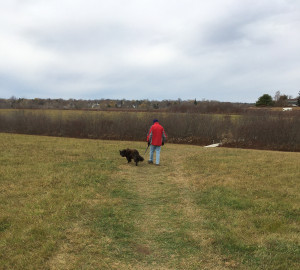 places to hike and walk. Here on the small St. George Peninsula alone, there are at least five walking/hiking trails. Nearby are also public beaches where we have the ocean view as well. My husband and dog and I walked this Bobolink Trail in the Georges River Land Trust Riverview Hayfields Preserve not long ago. This field is one of the last remaining open hay fields on the St. George peninsula. It and provides critical habitat and a ‘flyway’ for migrating birds that feed and rest along the two rivers. Don’t like hiking? Go for a drive in the country. Find back roads and explore. You might be surprised. Grab your mask and head out.
places to hike and walk. Here on the small St. George Peninsula alone, there are at least five walking/hiking trails. Nearby are also public beaches where we have the ocean view as well. My husband and dog and I walked this Bobolink Trail in the Georges River Land Trust Riverview Hayfields Preserve not long ago. This field is one of the last remaining open hay fields on the St. George peninsula. It and provides critical habitat and a ‘flyway’ for migrating birds that feed and rest along the two rivers. Don’t like hiking? Go for a drive in the country. Find back roads and explore. You might be surprised. Grab your mask and head out.
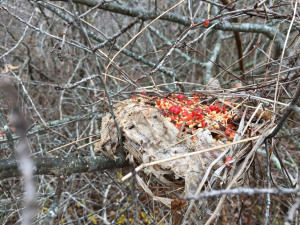 4. Take photos on your outing. Sometimes even a small, beautiful thing can elicit wonder. Once the leaves dropped this fall, I found this small bird nest in a bush next to a path where I walk the dog daily. It’s empty of baby birds, but full of seeds and little berries. I guessed the hoarder was a red squirrel who forgot it was there. The nest and contents are still there, but today covered with snow. On another walk one winter after a freezing rain, I snapped this shot of winterberries coated in ice. Instead of putting photos in regular photo albums, we’ve lately started doing a photobook a year created at an online company.
4. Take photos on your outing. Sometimes even a small, beautiful thing can elicit wonder. Once the leaves dropped this fall, I found this small bird nest in a bush next to a path where I walk the dog daily. It’s empty of baby birds, but full of seeds and little berries. I guessed the hoarder was a red squirrel who forgot it was there. The nest and contents are still there, but today covered with snow. On another walk one winter after a freezing rain, I snapped this shot of winterberries coated in ice. Instead of putting photos in regular photo albums, we’ve lately started doing a photobook a year created at an online company.
5. Exercise. See above for walking. Some gyms are open, but the idea of treadmills and stationary bikes while wearing a mask doesn’t appeal to me. I’ve discovered SilverSneakers.com, which is free online for those over sixty-five. They offer in-person classes, but not where I live. On days I don’t walk outdoors, I’m doing my exercise online, sometimes live and sometimes on video.
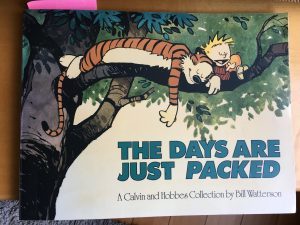 6. Laugh. My husband and I were clearing shelves and getting rid of books we’d read and wouldn’t revisit. We discovered our old collection of Calvin & Hobbes books from the 1990’s. We had to reread before ditching them. For those who don’t know Bill Watterson’s comic strip, it covers the misadventures and sometimes insightful Calvin, a mischievous and extremely imaginative six-year-old, and Hobbes, his stuffed tiger. The strip often veered into philosophical insights, many of which were prescient about today’s world. We reread, we laughed, we read again. And now of course we can’t ditch them, even the one with the corner chewed by our Sarah when she was a teething puppy. You can find these compilation books still. But only if you need a good, eye-watering laugh.
6. Laugh. My husband and I were clearing shelves and getting rid of books we’d read and wouldn’t revisit. We discovered our old collection of Calvin & Hobbes books from the 1990’s. We had to reread before ditching them. For those who don’t know Bill Watterson’s comic strip, it covers the misadventures and sometimes insightful Calvin, a mischievous and extremely imaginative six-year-old, and Hobbes, his stuffed tiger. The strip often veered into philosophical insights, many of which were prescient about today’s world. We reread, we laughed, we read again. And now of course we can’t ditch them, even the one with the corner chewed by our Sarah when she was a teething puppy. You can find these compilation books still. But only if you need a good, eye-watering laugh.
7. Decorate. The holidays, remember? If you don’t celebrate Christmas or Hanukkah, decorate for winter. Create your own ornaments or greenery at your door. I have no talent for decoration or crafts, but my winter box here is passable and lasts all winter—with watering. Here’s how. Purchase a florist green foam block. Soak it before you start adding greenery. Cut small fir and pine branches and stick them in the foam. I purchased holly and some artificial berry branches and added those for color. Later in January, when the winterberries appeared, I added those. No one but us will see our Christmas tree or candles on the mantle this year, but even the act of opening the boxes and putting every cherished item in its traditional place brightens my mood. And the lights and bright colors will continue to make me/us happy.
for decoration or crafts, but my winter box here is passable and lasts all winter—with watering. Here’s how. Purchase a florist green foam block. Soak it before you start adding greenery. Cut small fir and pine branches and stick them in the foam. I purchased holly and some artificial berry branches and added those for color. Later in January, when the winterberries appeared, I added those. No one but us will see our Christmas tree or candles on the mantle this year, but even the act of opening the boxes and putting every cherished item in its traditional place brightens my mood. And the lights and bright colors will continue to make me/us happy.
If anyone has further ideas of how to help ourselves get through the dark winter, please comment.
December 14, 2020
Christmas With Liss MacCrimmon
Kaitlyn Dunnett/Kathy Lynn Emerson here, pondering why so many publishers of cozy mystery series, including humorous mysteries, think Christmas is a good time to commit murder. In real life, of course, there are plenty of homicides over the holidays, mostly committed by those nearest and dearest to the victim. Not to make light of it, but stress is a killer. This year, with large family gatherings being discouraged due to Covid-19, it will be interesting to see if Christmas crime statistics are much different from the norm.
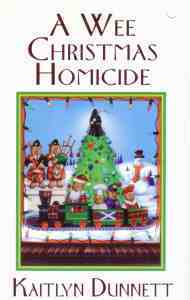 Getting back to fictional murder and mayhem, let me tell you about my personal experience with Christmas cozies. I wrote two of them for my Liss MacCrimmon mysteries. The first was the third book in the series, A Wee Christmas Homicide (2009). The premise of the story is that Liss and two other shopkeepers in Moosetookalook, Maine have fortuitously ended up with a supply of the toy every kid wants on this particular Christmas—Tiny Teddies. These stuffed bears are in short supply all over the U.S., but rather than sell what they have by mail order, the three agree to a plan to draw shoppers to them. With the help of other downtown businesses, they organize the “Twelve Shopping Days of Christmas.” Of course, things don’t go exactly as planned, and when one of her fellow business owners is murdered, Liss finds herself in the middle of another murder investigation.
Getting back to fictional murder and mayhem, let me tell you about my personal experience with Christmas cozies. I wrote two of them for my Liss MacCrimmon mysteries. The first was the third book in the series, A Wee Christmas Homicide (2009). The premise of the story is that Liss and two other shopkeepers in Moosetookalook, Maine have fortuitously ended up with a supply of the toy every kid wants on this particular Christmas—Tiny Teddies. These stuffed bears are in short supply all over the U.S., but rather than sell what they have by mail order, the three agree to a plan to draw shoppers to them. With the help of other downtown businesses, they organize the “Twelve Shopping Days of Christmas.” Of course, things don’t go exactly as planned, and when one of her fellow business owners is murdered, Liss finds herself in the middle of another murder investigation.
I don’t take murder lightly, but there are plenty of humorous moments in A Wee Christmas Homicide. For one thing, Liss ends up with the responsibility of caring for the birds needed in a portrayal of “The Twelve Days of Christmas”—including a foul-mouthed parrot. And she engages in a self-proclaimed too-stupid-to-live moment when she impulsively attempts to look for evidence of a crime she thinks is related to the murder—smuggling Tiny Teddies into Maine from Canada. Add a chase scene on snowmobiles and a couple of unique gifts to Liss from rival suitors on Christmas morning, and this mystery ended up being a lot of fun to write.
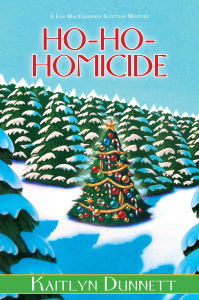 The second time Liss encountered a holiday murder, in Ho-Ho-Homicide (#8; 2014), my contract specifically called for a Christmas mystery. As with the first one, the story actually takes place leading up to Christmas Day, this time set on a Christmas tree farm a couple of hours’ drive from Moosetookalook. Liss is just supposed to be checking the place out for a friend who inherited it, and taking a well-deserved week’s vacation, but it doesn’t take long for her to discover that the previous owner disappeared under mysterious circumstances, possibly related to an unsolved murder, and that there’s something odd going on the nearest town.
The second time Liss encountered a holiday murder, in Ho-Ho-Homicide (#8; 2014), my contract specifically called for a Christmas mystery. As with the first one, the story actually takes place leading up to Christmas Day, this time set on a Christmas tree farm a couple of hours’ drive from Moosetookalook. Liss is just supposed to be checking the place out for a friend who inherited it, and taking a well-deserved week’s vacation, but it doesn’t take long for her to discover that the previous owner disappeared under mysterious circumstances, possibly related to an unsolved murder, and that there’s something odd going on the nearest town.
I loved writing this one because, at the time, my husband and I were operating a small mom-and-pop Christmas tree farm, open for sales from the day after Thanksgiving until Christmas Eve. That experience gave me lots of details I knew about first hand, although the operation Liss encounters is a much more commercial one than 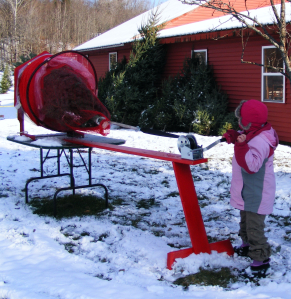 we ever had. Our netter—used to put netting around a tree to make it easier to transport—became a key part of the story. This novel isn’t as lighthearted as A Wee Christmas Homicide, but it has its moments. I was also able to use a couple of plot points that came straight from local headlines earlier that year—the discovery of a body in a freezer in a storage unit and some illegal activities connected to a dance studio. I won’t go into detail for those who haven’t Ho-Ho-Homicide, but let’s just say that when Jimmy Fallon held up a copy of the paperback reprint of the book on The Tonight Show and made a joke about the title, he wasn’t as far off as he probably thought he was. I doubt he read the book, but he gave me the best pull-quote an author could hope to have: “It has two things everyone likes, Christmas and murder.”
we ever had. Our netter—used to put netting around a tree to make it easier to transport—became a key part of the story. This novel isn’t as lighthearted as A Wee Christmas Homicide, but it has its moments. I was also able to use a couple of plot points that came straight from local headlines earlier that year—the discovery of a body in a freezer in a storage unit and some illegal activities connected to a dance studio. I won’t go into detail for those who haven’t Ho-Ho-Homicide, but let’s just say that when Jimmy Fallon held up a copy of the paperback reprint of the book on The Tonight Show and made a joke about the title, he wasn’t as far off as he probably thought he was. I doubt he read the book, but he gave me the best pull-quote an author could hope to have: “It has two things everyone likes, Christmas and murder.”
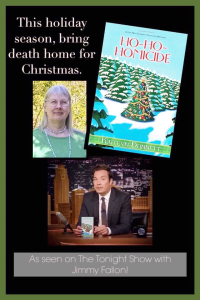
Both books are still available to buy. In fact, both are currently priced at only $1.99 e-book format. The links to the publisher’s pages below will take you to assorted online bookstores. Copies of the hardcover and mass market paperback editions are still available from a few stores and, as always, your local library, if it doesn’t own copies, can order them through inter-library loan.
https://www.kensingtonbooks.com/9780758262042/a-wee-christmas-homicide/
https://www.kensingtonbooks.com/9780758292858/ho-ho-homicide/
Do you read or reread Christmas-themed mysteries at this time of year? Why do you think there are so many of them?

Kathy Lynn Emerson/Kaitlyn Dunnett has had sixty-three books traditionally published and has self published several children’s books. She won the Agatha Award and was an Anthony and Macavity finalist for best mystery nonfiction of 2008 for How to Write Killer Historical Mysteries and was an Agatha Award finalist in 2015 in the best mystery short story category. She was the Malice Domestic Guest of Honor in 2014. Currently she writes the contemporary “Deadly Edits” series (A Fatal Fiction) as Kaitlyn. As Kathy, her most recent book is a standalone historical mystery, The Finder of Lost Things. She maintains websites at www.KaitlynDunnett.com and www.KathyLynnEmerson.com. A third, at A Who’s Who of Tudor Women, is the gateway to over 2300 mini-biographies of sixteenth-century Englishwomen.
December 13, 2020
Messiah. Nutcracker. Blizzards. Butter. And Gratitude.
Quick Sidebar: 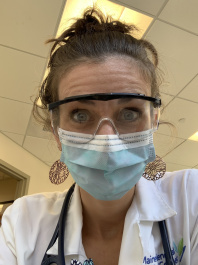 My daughter (here) is a Physicians Assistant and says she sometimes feel safer at work than out running a few errands where some people are lax on protecting each other. So, let’s do our BEST for her and for EVERY health care worker in the universe. OK? Thx.
My daughter (here) is a Physicians Assistant and says she sometimes feel safer at work than out running a few errands where some people are lax on protecting each other. So, let’s do our BEST for her and for EVERY health care worker in the universe. OK? Thx.
Sandra Neily here, sharing winter writing, winter performances you can stream and enjoy, and what I love about winter.
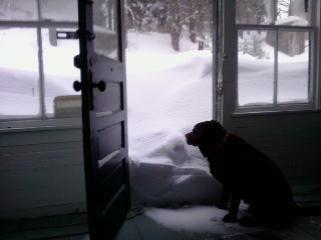
I am grateful for blizzards that bury the car and my To-Do schedule as well.
Working on the third Mystery in Maine, Deadly Taboo, I dug into my personal misadventure archives searching for a way to start the novel. (Yes, this moment did really happen to me. “Don’t ignore personal experiences if they work for you,” said a writing mentor.)
Setting up the Deadly Taboo excerpt: tracking lynx across a late winter landscape, Patton and her often wayward dog discover that maybe spring is already on its way.
Up to my waist in broken ice, snowshoes scrambling for good footing in the melting marsh, I struggled for breath as freezing water saturated clothing and skin. I wasn’t too busy to miss Pock sinking into a happy crouch. My dog was a Lab. Water—any water— was heaven-sent.

I learned to respect March outings by keeping close to shore where it’s only ankle deep. Or taking a nap.
“Nooooooo,” I yelled. “No, don’t jump! Not fun in here. Not FUN! …
********
Before we go outdoors, here’s at least two things I will be streaming this holiday season. (After watching my fav holiday movie “Love Actually” too many times.)
The Oratorio Society of New York starts sharing the “Messiah,” on December 21. I may listen at least twice.
And during this time when so many dance companies have to give up desperately needed income that multiple Nutcracker performances bring to them, I will pay for a ticket to see it performed on line by the San Francisco Ballet.
Now for the outdoors: here’s the link to a recent post where I shared ways to find snowshoeing locations and tips for taking the kids with you. New Season. Same Pandemic. But New Get-Out-There Strategies | Maine Crime Writers
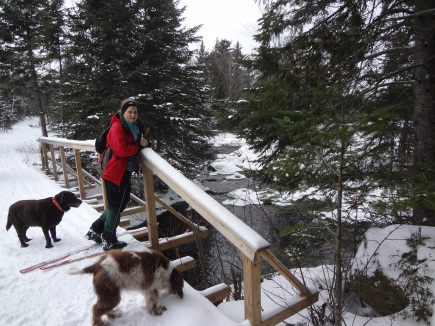
Grateful for West Branch Pond Camps grooming trails we can use.
Each of these long, early-dark days, I am working on being grateful for things I haven’t thought about recently. And here they are:
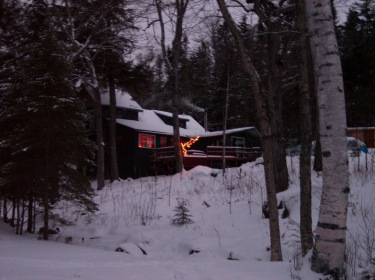
In my novels it’s called Antler Camp, but it’s really just home.
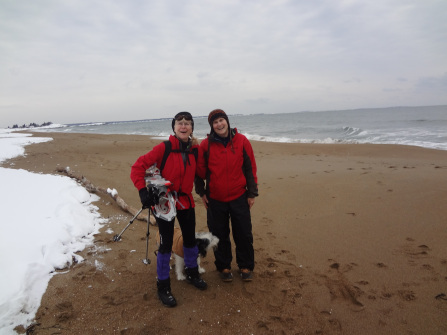
With Fran, a snowshoe out and a walk back on the beach: Reid State Park. And it’s open all year!
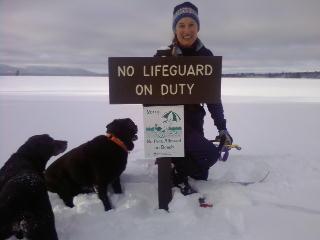
With Sally: Lily Bay State Park with miles and miles of the sound of snow under our skis.
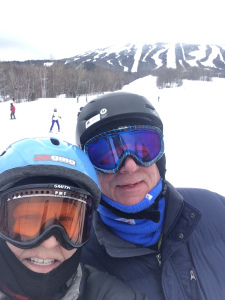
Glad Bob and I got in a ski before the Loaf closed last winter.
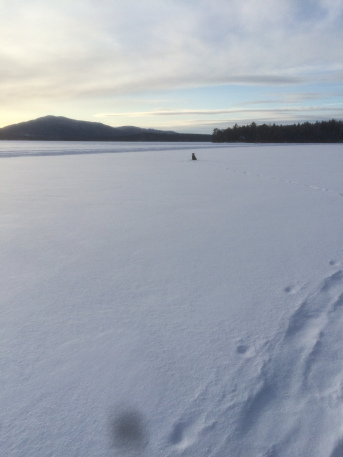
My dog Raven is the black dot waiting for me. No lift lines.
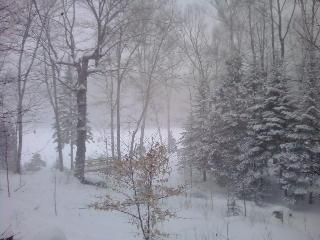
A cup of tea, watching as the storm comes in off the lake.

Grateful to have a daughter who isn’t fazed by combining winter and motherhood.

Very pleased I’ve stocked my freezer with butter. This is really just BUTTER in disguise.
Wishing all our Maine Crime Writers’ authors and readers a crisp-feeling new book you’ve been dying (well, it’s always on our writer brains …) to read. You’ll find many here with our authors!
Sandy’s novel “Deadly Trespass, A Mystery in Maine,” was a finalist in the Maine Literary Awards, a recipient of a Mystery Writers of America national award and a national finalist in the Women’s Fiction Writers Association “Rising Star” contest.. Her second Mystery in Maine novel, “Deadly Turn” is now in Sherman’s Books and on Amazon in Kindle and paperback. She lives in the Maine woods and says she’d rather be “fly fishing, skiing remote trails, paddling near loons, or just generally out there.” Find more info on her website .
December 11, 2020
Weekend Update: December 12-13, 2020
 Next week at Maine Crime Writers there will be posts by Sandra Neily (Monday), Kaitlyn Dunnett/Kathy Lynn Emerson (Tuesday), and Susan Vaughan (Thursday), with a group post on “Books We’re Giving” for Friday.
Next week at Maine Crime Writers there will be posts by Sandra Neily (Monday), Kaitlyn Dunnett/Kathy Lynn Emerson (Tuesday), and Susan Vaughan (Thursday), with a group post on “Books We’re Giving” for Friday.
In the news department, here’s what’s happening with some of us who blog regularly at Maine Crime Writers:
Rumor has it that some of our writers are busy writing holiday stories for you, so stay tuned.
Results of our body contest will be in next weekend’s update, so we hope you’ll check in.
Kate Flora’s Schooled in Death is on sale this week. If you haven’t read it, here’s your chance:
https://www.bookbub.com/books/schooled-in-death-by-kate-flora?buy=&ebook_deal®ion=us
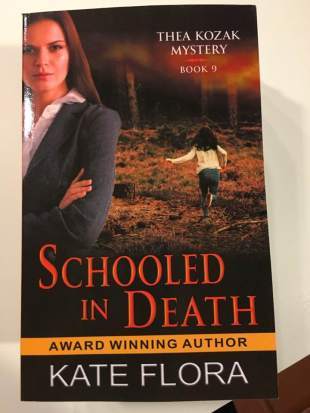
An invitation to readers of this blog: Do you have news relating to Maine, Crime, or Writing? We’d love to hear from you. Just comment below to share.
And a reminder: If your library, school, or organization is looking for a speaker, we are often available to talk about the writing process, research, where we get our ideas, and other mysteries of the business. We also do programs on Zoom. Contact Kate Flora
Eyewitness
I said in my last post I’m a very visual person. There’s nothing like being and seeing for oneself. I’ve been lucky to travel for historical research. When one writes about the United Kingdom in the Regency, Victorian, Edwardian, and Roaring Twenties eras but lives in a little Maine college town in the 21st century, one needs all the help one can get.
I’ve made some great accidental discoveries. One year, my husband and I stayed in Pitlochry, Scotland, “the gateway to the Highlands.” We stayed in a lovely B & B, but our room was at the tippy-top floor of the old manor house (probably the original servants’ quarters) and the stairs were positively evil. If I’d been a maid back then, I would have handed in my notice or, more likely, tumbled down the steps to my death.
Consequently, we planned our days to spend most of the time out and about so we were only climbing up the horrible stairs at the end of the day. I made a list of local sites to explore from the area brochures each evening, and the next morning we dutifully ate a huge “full Scottish” and trotted out, list in hand.
I’d read there was a museum in the basement of the nearby Atholl Palace Hotel, a gargantuan Scottish Baronial pile that has served as a tourist destination for almost a hundred and fifty years. In the Victorian era, city dwellers fled to the Highlands to get fresh air, and stayed at hydropathic spas, where they were basically tortured in hot and cold water for their “health.” The plot and setting for In the Heart of the Highlander came to me as I wandered around the displays frantically taking notes.

(A few years later we went back in Pitlochry to stay in the hotel itself. I got a bonus surprise—a wedding reception was taking place and I saw lots of handsome young Scotsmen in their kilts. I did not try to sneak a peek under them to answer that age-old question, however.)
A trip to London provided me with the inspiration for house my artist hero lived in in The Reluctant Governess. The Linley Sambourne House is an absolute treasure trove of eccentric collectibles, although I would not like to have to dust its five floors. It too had evil stairs, but I persevered all the way up to the attic. I was lucky enough to snag the last spot on a private tour, and would recommend a visit.

The Geffrye Museum, also in London, is a fabulous resource to see how people lived over the centuries, with authentically decorated rooms you can imagine your characters, in whatever decade they “exist.” The building was formerly an alms house, so you can also experience what the space might have been like for its original tenants.

My very favorite place to visit, The V & A, is filled with clothing, jewelry and household decorative objects that you can mentally borrow for detail in your writing. Most of these museums have wonderful websites to explore, when travel (or money) is limited, as it is now.

I think my historical museum mania was formed on my tenth birthday, when my parents took me to Sagamore Hill, Teddy Roosevelt’s big shingled house in Oyster Bay. I was a little voyeur, wondering what it would be like to sleep on such grand beds in such grand bedrooms, although the dead animals hanging on the walls everywhere were a bit of a turn-off. From there it’s been on to Newport mansions and Sturbridge Village and Cawdor Castle and Buckingham Palace.

Do you like to step back in time? What’s your favorite museum or historic house?
December 10, 2020
Stuck In The Middle With You!
Everyone remembers the great song Stuck in the Middle With You by Stealers Wheel. It played prominently in Tarantino’s classic crime move, Reservoir Dogs. But the song is not what I’m talking about here in this post. What I’m referring to is the writer’s journey into the dreaded middle of their story. The Middle is where the tent starts to sag. Where we put on those extra pounds. Where the birth order can go very wrong (only joking).
How many times have you started reading a crime novel and it starts out with a bang, only to have the story start to drag halfway through? It’s disappointing and a reason why many readers skim through this part of a book. Believe me, it’s difficult for us writers, too. The question is: how do we strengthen the dreaded Middle part of the story in order to keep the reader’s attention?
The dreaded Middle. In the worst case scenario, it’s rudderless filler meant to pad the word count. Oftentimes, what constitutes the Middle of a novel is too much exposition, ill-advised detail, excessive dialogue and nefarious subplots that add nothing to the plot. Suffer through these boring plot devices and we finally get to the climax and denouement.
So how do we avoid this problem as writers? How do we keep the arc of the plot rising to its exciting apex? Then to have the story accelerate like a rollercoaster down its steep tracks, and heading toward its shocking ending?
The key to conquering the dreaded Middle is first not think of it as the middle. Break down your novel into smaller components. Think of each chapter as a story arc unto itself. Now not all chapters need to be as thrilling and exciting as your opening and ending sections, but there needs to be tension and some expectation of a payoff. Visually, envision your novel as a hurricane racing across the Oklahoma plain, and within it spins hundreds of smaller tornadoes all churning and driving the larger, more destructive storm that is your killer story.
Dialogue is key to creating this ongoing tension. Every line of it should have meaning and be able to move your plot along. A useful tool is misdirection, meaning that what a character says is not always what they mean. This happens so often in our real lives that we take it for granted. And what a tool it is! Ask someone how it’s going and they invariably respond with, “Fantastic.” But we know from the law of averages that not everything is always fantastic for people. Sometimes they’re lying to save face. They don’t want to tell you about their painful hemorrhoids or the fact that their spouse has a drinking problem. If you really listen to a conversation between two people, the dialogue is merely a device to establish social etiquette and increase status, with varying motivations n between, and not necessarily an honest representation of what’s really happening in their lives.

Your doctor asks how many drinks a week you consume. Your wife asks how she looks in a particular dress. A mother sends out an annual Christmas letter filled with half truths. See what I’m getting at. People often talk past each other to put themselves in a better light. In real life it’s fascinating to observe, but in crime fiction it can really drive the internal forces in your crime story, helping you ratchet up the dreaded Middle.
One visual I use during the writing of my novels is that of a steel bar. If it remains straight while you’re writing, the story remains flat and uninteresting. I repeatedly have remind myself in the Middle to keep “Bending the Bar” as I write. At every step in the novel, I try and Bend the story Bar, meaning that I need to ramp up the tension in every scene. I close my eyes, grip that proverbially steel bar, and use all my strength to bend it for the sake of the plot. I’m very satisfied at the end when my story line resembles the Gateway Arch.
Micromanage your novel. Every sentence should be interesting, tense and packed with meaning. Make these sentences miniature tornados rotating around each other within the paragraph. Then the paragraphs spinning dervishes within the chapter. The chapters violent wind storms within the novel. In this manner, every part of the novel is churning and moving everything toward it’s thrilling denouement. Do this and your story will be the equivalent of an F-5 Tornado blazing across the Kansas landscape.
In some sense, it’s best not even to think of your Middle as a middle. Just as time is not something readily observable in the universe, the Middle can be crushed by breaking down your novel into subatomic structures, protons, electrons and neutrons all buzzing around each other, attracting and repulsing, leading to something resembling the end of the universe. Or an atomic explosion. Thus the Middle becomes not a particle but just another wave undulating through the story ether.
The Middle has plenty of unfortunate connotations. The middle child. Middle age crisis. Middle-of-the-road. The middle that grows around our waist. But it doesn’t necessarily have to be a bad thing if we don’t view as such. The best writers can make the Middle as exciting and thrilling as the beginning or ending.
So be not afraid of your Middle. Embrace it and view it as an opportunity to make it the best part of your novel. Let it be the literary landscape where you shock and awe, and breathe much-needed life into your plot. Think of it as a way to add all sorts of interesting motivations and action sequences. A place where dialogue shines, ambiguous and unreliable, and in the end reveals true character. The Middle is what gives your story it’s depth, dynamism and dimension. The Middle, when you come right down to it, my dears readers, is the fascinating life we all lead between birth and death.

December 9, 2020
The Tribe of Mystery Writers of Maine
Friends, today our guest is Matt Cost, sharing some thoughts about the Maine writer’s tribe and his new books:



Hello, Matt Cost here, visiting for the day. I’m a writer of histories and mysteries. I wanted to share my insight into the fantastic crime writing scene happening right here in Maine.
In 2015 I self-published a historical on Joshua Chamberlain and the Civil War. At that point, I gave up teaching to devote myself to writing and promoting my work. I went to several conferences, Writer’s Digest, Slice Literary, to name two, but never quite felt like I fit in. It was not my ‘tribe’. Nonetheless, I finished another historical, “I am Cuba; Fidel Castro and the Cuban Revolution”, as I looked for my niche in life.
[image error]
It was at this point that I stumbled upon the outstanding Encircle Publications who agreed to publish my Cuba book that was released in March of 2020. Right from the start, I was taken in by the owners, Cynthia Bracket-Vincent, and her husband, Eddie. As the primary focus of Encircle was mysteries, I began to think about shifting back to writing in that genre, something I’d dabbled with some twenty years earlier.
It was with that end in mind that I attended my first Maine Crime Wave in 2019. Right from the start, I realized that something was different about this conference. People were just so darn friendly. It didn’t matter whether they were a reader, an unpublished author, a best-selling author, or somewhere in between. There was a sense that everybody was in this thing together.
Over the course of two days, I met and was introduced to countless wonderful authors. There was Gerry Boyle who I’ve since learned worked with my stepmother at the Waterville Morning Sentinel in Skowhegan. The wonderful Barbara Ross of cozy mystery fame. Chris Holm, author of the Michael Hendricks thriller series that I’ve enjoyed. A little-known author named Julia Spencer Fleming chatted with me for ten minutes about this and that.
This was where I first got an opportunity to meet Bruce Robert Coffin, an author I greatly admired for his John Byron series. I’d get a chance to know him, there at Crime Wave, and at two more conferences I’d attend that year. His energy and charisma are inspiring.
Throughout that first mystery conference, I was taken under the wing of Dick Cass, fellow Encircle Publications author of the jazzy Elder Darrow series. I’d just read my first book in his series and the rest would follow quickly. Dick would go on to invite me as a guest speaker to his writing class and would write a blurb for the jacket of “I am Cuba” when it came out the following year.
Later in the summer, I attended Thrillerfest in NYC. There, I overlapped several Maine authors I’d met at Crime Wave, and many more, suggesting that the embrace of the mystery writing community was larger than just Maine. Not that I was in the bar all weekend, but I met two best-selling authors in that venue after hours and had fantastic conversations, aided no doubt by spirits. There were so many more, authors trying to get their foot in the door like me, those halfway up the ladder, and those on the top, reaching their hands down to help others up.
At the bus stop, on my way out of New York City, I had a fantastic conversation with Paula Munier, and while she technically lives across the border in New Hampshire, it is close enough to give her honorary Maine status, if not quite considered a local for another three generations.
I left that conference hungry for more interaction with the mystery writing community. The next opportunity was at a brewery in South Portland where a collaboration of Maine mystery writers was doing short readings while eating pizza and drinking beer. What a great place to be introduced to the fabulous writer, Joe Souza! I was not yet familiar with Joe at the time, but bought my first thriller from him, and was blown away. Not just by the writing, but by the warmth of his personality and support as a writer.
In November, I attended Crime Bake, which really is just a conference for Maine South, and perhaps a few others from around the country who’ve won the highest awards and sold the most books, as well as others who were just as happy writing books without as yet having received the monetary nor critical rewards. At one point, I was having a nice conversation with a woman named Lori, which unfortunately kept getting interrupted by people stopping by to congratulate her on being nominated and winning various awards called the Edgar, Anthony, and Mary Higgins somebody.
While 2020 has been the year of Covid-19 and staying home, my mystery tribe has continued to expand virtually. I’ve interacted through book launches, panel discussions, and presentations over the year, building upon the connections that I’ve made and creating new relationships.
A large part of my burgeoning family is through Encircle Publications, a small publisher here in Maine who has begun to turn out award winning authors, but more importantly, a collection of good people. Through Cynthia and Eddie, I’ve become good friends with the mystery/thriller authors BJ Magnani and Sandy Lee Manning, who don’t quite live in Maine, but Massachusetts and Vermont are close enough to be included. Kevin St. Jarre from Cape Elizabeth, while not a mystery writer as of yet, is a wonderful writer and still holds the promise of being converted. There are countless others, Encircle Publication authors, who get together via Zoom once a week to share, talk, lament, and laugh.
And of course, I must thank Kate Flora, who has done so much for the writing and mystery community that we call Maine. Thank you for having me as a guest writer and thank you all for welcoming me to the tribe.
About Matt Cost
Through this journey, started so late in my life, I’ve found my tribe. My first Goff Langdon Mainely Mystery, “Mainely Power” was published in September, and the second, “Mainely Fear” just came out last week. The third, “Mainely Money”, will be published in March. I’ve also signed a contract for three new Clay Wolfe mysteries set in the fictional town of Port Essex, Maine. Not to give up on the histories entirely, I’ve a historical murder mystery, “Love in a Time of Hate; New Orleans During Reconstruction”, coming out in September.
Over the years, I’ve owned a video store, a mystery bookstore, and a gym. I’ve has also taught history and coached just about every sport imaginable. I now live in Brunswick, Maine, with my wife, Harper. There are four grown children: Brittany, Pearson, Miranda, and Ryan. A chocolate Lab and a basset hound round out the mix. I now spend my days at the computer, writing.
December 8, 2020
“Son, can you play me a memory?”
John Clark on memories of Sennebec Hill Farm, some recent, others not. I was going to sum up my November hunting season today, but when I got up this morning, I was in a bit of a nostalgic mood, probably triggered by a black humor realization yesterday while shoveling heavy wet snow. I’m the same age as my grandfather, Dr. Arthur Hight Clark was when he died from a heart attack while shoveling snow way back in 1953
[image error]M2E1L0-0R350B300
Modern medicine is a two edged sword. It prevents many from dropping dead like Gramps, but the alternatives (slow wasting away, dementia, cancer, etc.) really suck IMHO. Give me the outta here quick any day, but I digress. My ill-fated experience with deer ticks 11 years ago kept me from hunting for ten years. When I began having recurring hunting dreams in early 2019, coupled with the realization that I could buy a lifetime hunting and fishing license for eight bucks, I splurged and went back in the woods. Last year, I only went three times and saw zilch. This year, I was more enthusiastic, but you can’t fight reality. I have terrible arm strength these days (the main reason I sold my gas snowblower and bought an electric one) but wanted to put up a portable tree stand on the knoll across from the farmhouse.
Every year, I have Bernard Brown bush hog the orchard to keep it from being overtaken by poplars, alders and assorted fast growing things. In years past, I’d drive past the old henhouse foundation up a rise, along the blueberry field and across the orchard. There was a line of old apple trees along the stone wall that offered food and hiding places for partridges, but those are long gone. At the end of the wall, a woods road went almost all the way through to the neighbor’s property line. I was a bit uneasy about taking my Hyundai over that terrain, having done so in pick-ups in the past, but the car did just fine, cutting the distance necessary to lug and erect the metal stand. It was late September when I made my first trip, this one with a goal of clearing logs, limbs, etc as well as trimming a pathway to the top of the small hill. Deer use it as their primary hangout because it’s nearly impossible to get to the top without their sensing you. This is because wind currents swirl up there no matter what the weather might be.
I spent a good three hours clearing and trimming as well as finding a big fir to hook the tree stand to. Remember my comment about lack of arm strength? It took two hours to put it together and two more trips to carry everything up the hill with frequent breaks needed to catch my breath before erecting and securing it. I should know after years of hunting that sitting still, even with a good book in hand which I always take with me, only lasts a couple hours before that crazy fellow in the back of my head starts insisting I’m in the wrong spot. After giving in to his entreaties, I moved very slowly and carefully, heading south just below the ridge line. Less than 50 feet from my stand, I could see where deer had been lying down the night before and another 50 feet after that a buck had torn up a patch of ground that was close to three square yards in size. After passing two oak trees that were huge when I first hunted at age nine, I angled down toward the swamp, scene of many successful duck hunts 45 years ago. On the way, I saw my first two deer, but they were too far away to consider taking a shot with my shotgun.
It was just after that when I realized something both interesting and unsettling-everything now looks bigger in the woods across from Sennebec Hill Farm. Before my hunting hiatus, I knew that land like the back of my hand. Today, it seems twice as large. Granted everything has grown, but it seems like Mother Nature took a huge breath and is holding it. I used to be able to walk freely along the edge of the swamp. I remember a day when I did so while an otter swam in tandem, his curiosity overpowering any fear he had. Today, such a trek is impossible and I have no idea how much water is running through the tall grass. The tote road has pretty much been taken over by small trees, and the granite outcropping where you used to be able to sit and view most of the lower hillside now has a much smaller vista.
Between the back of the orchard and the road leading to culverts where a small brook meanders into the beaver bog is an area that was logged two years ago. As I moved along another tote road paralleling the upper part of the swamp, I saw two deer run across the open area ahead of me. Again, they were too far away to think about a shot. While I was allotted a doe permit as well as a bonus permit, my drive to shoot a deer wasn’t that strong, leaving me ambivalent about doing so. Simply being in the woods for hours at a time, pretty much having it all to myself was plenty of satisfaction. I saw turkeys, a ton of red and gray squirrels, lots of geese down on Sennebec Lake, and heard two different species of owls. The two outlaws who used to hunt the farm drank themselves to death and all that remains of their dubious legacy are several barely standing tree stands. They also left a 16 foot aluminum ladder half hidden in a copse of fir trees that I may retrieve come spring. It took less than half an hour to take down and carry the tree stand back to my car. On the way up to get it, I thought about how I hadn’t seen a single partridge. No sooner had that thought crossed my mind than two flushed in opposite directions
I’ll return to hunt again next Year, God willing, probably as content just to wander and wonder as I did this year.
December 6, 2020
Lynne Raimondo – A Tribute
Our crime writing family is mourning the death of Lynne Raimondo, who died on November 12. The author of three acclaimed novels, Lynne had colleagues, friends and admirers across the country and around the world. We in Maine were fortunate that Lynne—who had a home on Mount Desert Island as well as in Evanston, Illinois—was a member of our particular crime writing community.
[image error]
Lynne Raimondo
Lynne was a driving force behind Murder by the Book, the crime writing conference held each fall at the Jesup Memorial Library in Bar Harbor, and she often returned to Maine in time to take part in the Crime Wave conference in the spring. A standout talent, she was engaging and helpful, happy not only to chat over lunch, but to do what she could to help others advance their careers.
Lynne was a lawyer as well as a writer, having been a partner at a prominent Chicago law firm, general counsel for a big-five accounting firm and of the Illinois Department of Revenue. As her good friend Lori Rader-Day said in a Facebook post at the time of Lynne’s death, she did not take it lightly if a writer mischaracterized some aspect of Illinois law.
Make that law generally. I’m also a lawyer, but don’t practice criminal law. When Lynne beta-read a manuscript for me last fall she set me straight on several matters of criminal practice and procedure, including how criminal defense lawyers deal with clients who are obvious liars. I tackled revisions with her advice in the very front of my mind.
[image error]
Lynne, far left, laughing with her head in her hands, at a Murder by the Book panel discussion with Beth Ineson, Jim Ziskin, Dorothy Cannell, Julia Spencer-Fleming and me.
Lynne, far left, laughing with her head in her hands, at a Murder by the Book panel discussion with Beth Ineson, Jim Ziskin, Dorothy Cannell, Julia Spencer-Fleming and me.
Lynne worked hard to get the details right in her three acclaimed novels—Dante’s Wood, Dante’s Poison and Dante’s Dilemma—which had as their protagonist Mark Angelotti, a blind psychiatrist.
[image error]
The cover of Lynne’s first book.
In a piece published in the August 2015 edition of The Big Thrill, Lynne told interviewer Stephanie Gayle that while creating Mark’s character she read autobiographies, academic papers and blogs, “whatever I could find that would give me insight into the physical, emotional and social challenges faced by people with disabilities.” She read medical literature about Leber’s Hereditary Optic Neuropathy, the condition that caused Mark’s blindness, and she incorporated into her stories real-world high-tech tools like screen readers and smartphone apps, which Mark uses to investigate crimes. “I don’t make any of this stuff up,” she said. “I think it adds something special and different to the books.”
Lynne’s life involved so much more than her work as a lawyer and a writer. She and her beloved husband Stanley Parzen were the parents of three children, and boy, did her face light up when she spoke of Kendra, Jacob and Tamsin.
She loved to cook, and often posted photographs online of dishes she’d prepared. Lobster Pad Thai. Lamb Shanks with Oranges and Olives. Ratatouille, which she noted “takes some of the sting out of the end of summer.”
She loved to travel (Antarctica last year, Croatia in 2018) and hike the trails of Acadia National Park. She was immensely proud of her Italian heritage and a huge fan of the Chicago Cubs. She was a skilled gardener and a talented watercolorist.
I wish I’d known her better and longer, because every interaction with Lynne Raimondo was wonderful.
◊
Last week I reached out to several friends who were close to Lynne and invited them to comment here. The aforesaid Lori Rader-Day, an award-winning author who just finished up a term as President of Sisters in Crime, sent the following:
“When I first heard of Lynne Raimondo, on the website of the publisher of her first book, Dante’s Wood, I knew we were meant to be friends. The same publisher had just offered to publish my first book. In that first rush of excitement, received at my day job, I visited the publisher’s website to check them out, and there was Lynne—who lived just down the street from where I sat. Fate. We met for Indian food and did that meet-cute thing where two strangers, not knowing what the other looked like, sat at two separate tables, waiting for the other to show up.
“We built a quick friendship based on books, good food, wine, laughter, and gossip. I think every friendship of Lynne’s must have been built from those same layers: good food, a Negroni, two Negronis, heartfelt conversation, honesty, laughter. None of us were ready for it to end.
“As a writer, Lynne Raimondo was a fierce professional. Getting the details right meant everything. For her novels, in which the main character solves crime despite going blind, Lynne reached out to people living with eyesight deterioration and made sure that the real issues and prejudices they faced (and the active lives they lived) were included in her stories.
“Long before those of us in the mystery community knew her, Lynne had already proven herself a powerful figure for justice as an attorney and a passionate protector of her family, a loving wife to Stanley, a loving mother to Kendra, Jacob, and Tamsin, an attentive daughter, an adventurous traveler, a talented cook, a loyal friend. She was uncompromising when it came to the quality of her work but also to the quality of her life. It was too short—Lynne had many more stories to tell, so many more of life’s adventures ahead of her. But Lynne Raimondo lived the hell out of the years she had. That feeling of loss I have, that so many people have now, like we are all sitting alone at our table waiting for Lynne to show up and make sure we order the best thing on the menu—that’s simply the lull after the life of the party has gone home.”
◊
Ron Beard, board chair at the Jesup Memorial Library, where Lynne sat for many years on the Board of Directors, posted the following remembrance on the library’s website:
“It’s no mystery what it takes to make a good board member and we at the Jesup Library are still in shock as we come to terms with the loss of our good friend Lynne Raimondo. Lynne came to the Jesup Board of Directors through her popular Dante novels, featuring a resourceful consulting psychiatrist solving intricately woven cases in Chicago. Those cases and knowledge of that locale were the result of Lynne’s career as a trial lawyer. The authenticity of her writing made her a very popular contributor to Jesup’s writer panels and talks.
“We were fortunate that Lynne brought her intellect, keen wit and straightforward manner to the work of our board of directors. Her savvy questions and experience were of great value in our deliberations. She loved the library. She loved Mount Desert Island. Her place at our table will always be like the beloved book that is missing from its accustomed place on the shelf.”
◊
And writer James Ziskin, author of the marvelous Ellie Stone series, who shares Lynne’s love of Italy and its culture, said:
“When my writing career was just getting started, Lynne was the first writer I met. Our editor put us in touch via e-mail, and we hit it off immediately. She read my first book and provided me with my very first blurb. I read her wonderful books with great enthusiasm and attention. She was my great pal.
“I spoke to her about three weeks before she passed away. Just chatting over the phone. We were making plans to get together in Maine with Stanley and my wife, who thought the world of Lynne. When I heard the news of Lynne’s death, I was crushed. I still can’t quite get myself to believe it’s true. It seems impossible.
“Lynne was incredibly talented. A great writer, lawyer, and painter, she was smart as hell and wickedly funny, too. In her third novel, Dante’s Dilemma, she named a doddering professor after me. So I returned the favor, calling a screeching soprano “La Raimondo” in my next book, Heart Of Stone.
From Dante’s Dilemma:
“I should warn you about our host,” Candace said while we waited for someone to answer. “Dean Oliver Armstrong, usually referred to around campus by the initials DOA. We’ll want to avoid getting stuck with him. Simply deadly. And then there’s Professor Ziskin, the retired head of the Italian Department. Poor old dear is nearly deaf and refuses to wear a hearing aid.”
Meaning we’d make a fine pair. I suddenly had doubts about what I was getting into, walking into a houseful of tedious academics. As it turned out, I needn’t have worried about the party being dull.”
From Heart of Stone:
“Mi chiamano Mimi,” sang Max from his armchair, but that was all he could manage. “I confess that I only know the first line.” He sipped his port. “Ellie, my dear, surely you know the whole thing. What comes next?”
“I’m tired Max,” I said. “I don’t feel like singing Puccini right now.”
“Fair enough,” he said. “One must be in the mood for opera, after all. As a matter of fact, I can’t stomach it in the main. The music is all right, but all that caterwauling gets under my skin. Disliked it since I was a boy. Since the first time I heard that soprano sing. What was her name? La Raimondo. That was it. Screeched like a barn owl and put me off opera forever.”
“I adore Puccini,” said Aunt Lena. “And La Raimondo was one of the great sopranos.”
“But more than the laughs we shared, I will always be grateful to Lynne for helping me find my moral compass. I was faced with a difficult ethical choice in the promotion of my writing career. I felt uncomfortable participating in a certain event, and Lynne talked me through it. She helped me realize that no publicity was worth sacrificing my principles, even a small measure of my principles. She did it without preaching or arguing. She was a terrific person, and I will always miss her.
My deepest sympathies to Stanley, Kendra, Jacob, and Tamsin, and all those who knew and loved Lynne. Addio, carissima. – James W. Ziskin, December 1, 2020.”
◊
I welcome the other Maine Crime Writers and readers of this post who knew Lynne or read any of her books to leave a remembrance in the comments. Memorial donations in her name should be directed to the Jesup Memorial Library in Bar Harbor, http://jesuplibrary.org.
Addio amico mio, e grazie.
[image error]
A lively MBTB panel discussion with me, Kate Flora, Gerry Boyle on writing characters of the opposite sex, with Lynne caught in the glow of late afternoon sunlight.
Lea Wait's Blog
- Lea Wait's profile
- 506 followers


